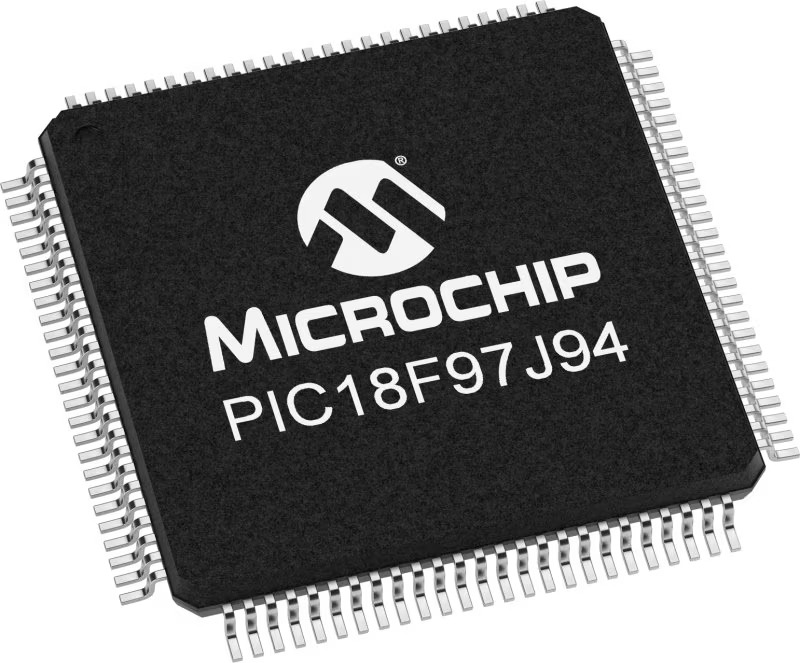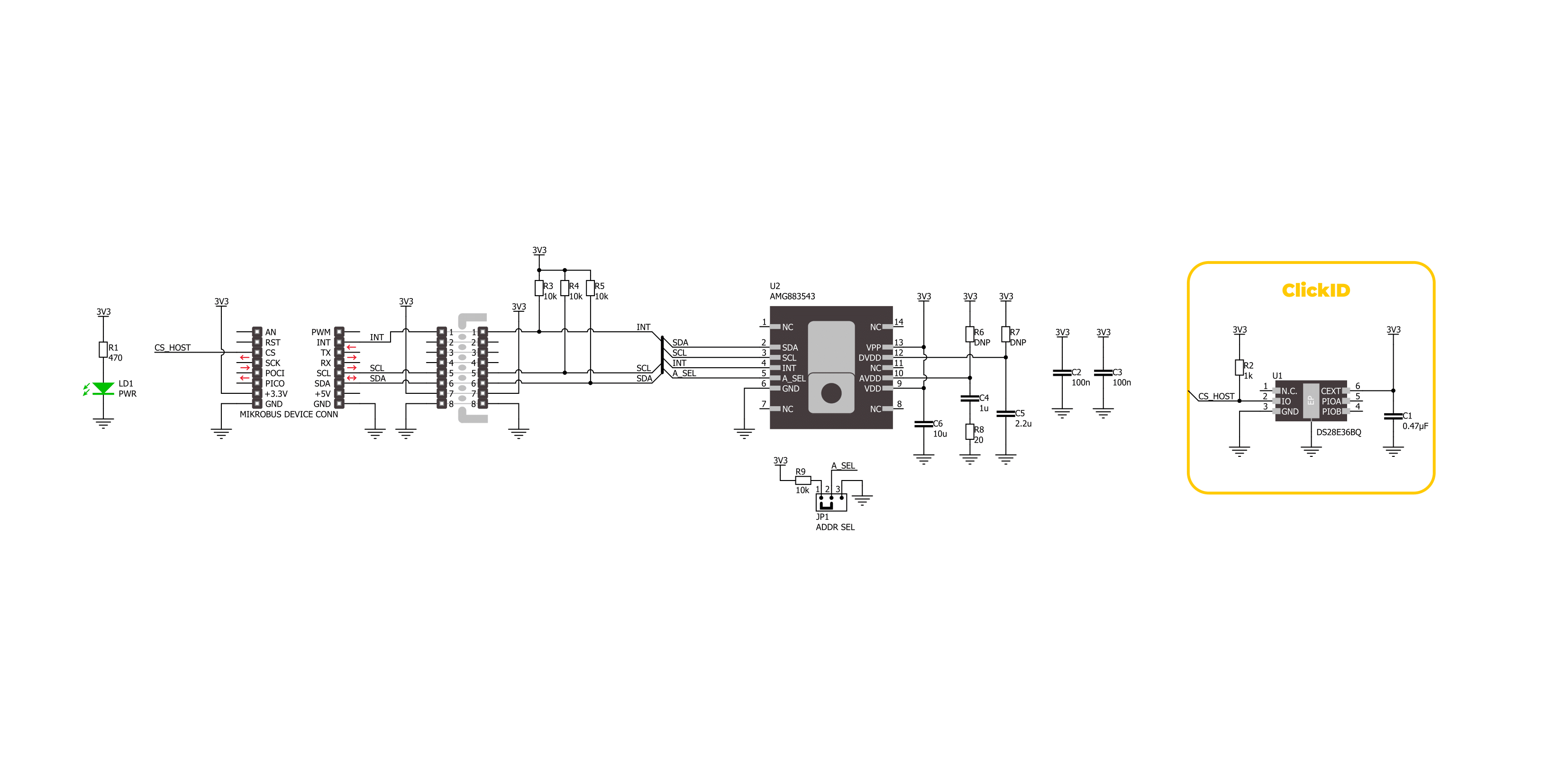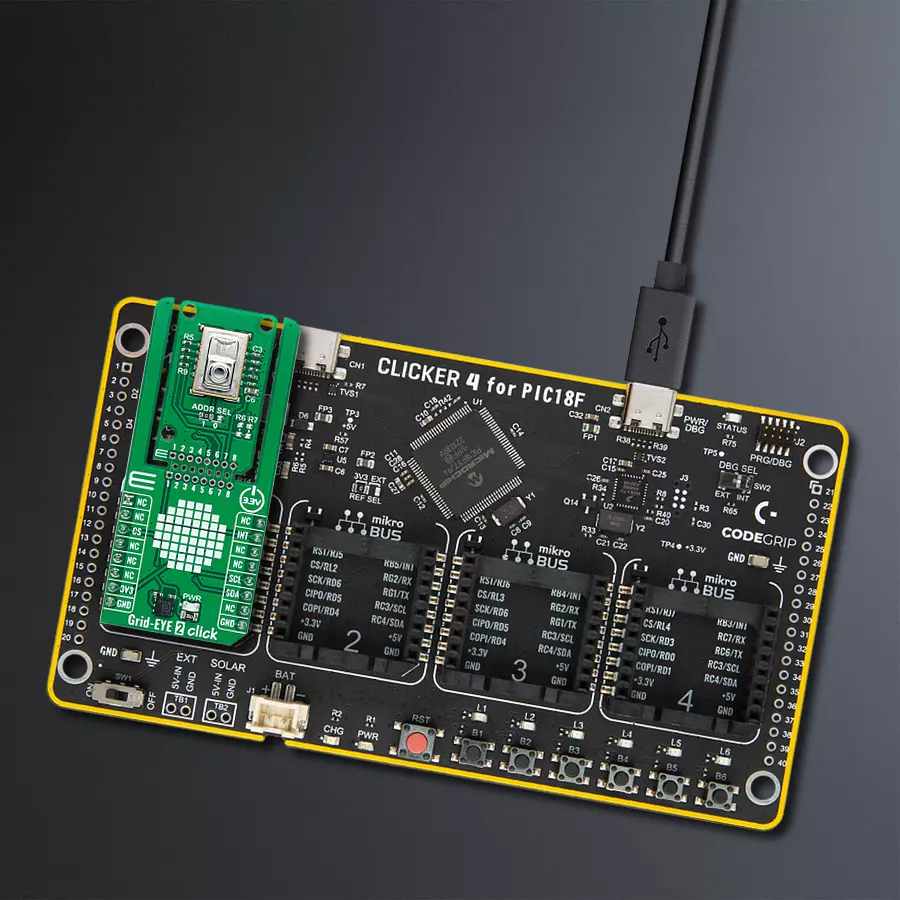Detect and measure temperature variations while identifying moving objects based on those changes
A
A
Hardware Overview
How does it work?
Grid-EYE 2 Click is based on the AMG883543, an infrared array sensor from Panasonic with a 90° viewing angle. It captures temperature data across a two-dimensional 8x8 matrix (64 pixels) and provides this information as a digital output. Each pixel measures temperatures ranging from 0°C to 80°C with a resolution of 0.25°C, allowing the detection of objects at distances up to 5 meters. With its ability to create thermal images and detect movement, Grid-EYE 2 Click is ideal for developing thermal imaging systems, monitoring people and objects, enhancing high-performance home appliances (like microwave ovens and air conditioners), promoting energy efficiency in offices (through air-conditioning and lighting controls), and applications in digital signage, automatic doors,
elevators, and more. This Click board™ is designed in a unique format supporting the newly introduced MIKROE feature called "Click Snap." Unlike the standardized version of Click boards, this feature allows the main sensor area to become movable by breaking the PCB, opening up many new possibilities for implementation. Thanks to the Snap feature, the AMG883543 can operate autonomously by accessing its signals directly on the pins marked 1-8. Additionally, the Snap part includes a specified and fixed screw hole position, enabling users to secure the Snap board in their desired location. Grid-EYE 2 Click uses a standard 2-wire I2C interface to communicate with the host MCU, supporting Standard mode with up to 400kHz of frequency clock. In addition to the I2C interface
pins, this board also uses an interrupt (INT) pin and a jumper for I2C address selection, ADDR SEL. The interrupt pin can signal the host MCU when a specific condition is met, such as when the temperature in any of the sensor's pixels exceeds a predefined threshold. This allows the system to respond immediately to changes in temperature without constantly polling the sensor, thereby saving processing power and energy. This Click board™ can be operated only with a 3.3V logic voltage level. The board must perform appropriate logic voltage level conversion before using MCUs with different logic levels. Also, it comes equipped with a library containing functions and an example code that can be used as a reference for further development.
Features overview
Development board
Clicker 4 for PIC18F is a compact development board designed as a complete solution to build your own gadgets with unique functionalities quickly. It features a PIC18F97J94MCU, four mikroBUS™ sockets for Click boards™ connectivity, power management, and more, and it is a perfect solution for the rapid development of many different types of applications. At its core is an 8-bit PIC18F97J94 MCU, a powerful microcontroller produced by Microchip, based on the high-performance CPU with two external clock modes, up to 64MHz. It
provides sufficient processing power for the most demanding tasks, allowing Clicker 4 to adapt to any specific application requirements. Besides two 1x20 pin headers, four improved mikroBUS™ sockets represent the most distinctive connectivity feature, allowing access to a huge base of Click boards™, growing on a daily basis. Each section of Clicker 4 is clearly marked, offering an intuitive and clean interface. This makes working with the development board much simpler and, thus, faster. The usability of Clicker 4 doesn’t end with its ability
to accelerate the prototyping and application development stages: it is designed as a complete solution that can be implemented directly into any project, with no additional hardware modifications required. Four mounting holes [4.2mm/0.165”] at all four corners allow simple installation by using mounting screws. For most applications, a nice, stylish casing is all that is needed to turn the Clicker 4 development board into a fully functional, custom design.
Microcontroller Overview
MCU Card / MCU

Architecture
PIC
MCU Memory (KB)
128
Silicon Vendor
Microchip
Pin count
100
RAM (Bytes)
3862
Used MCU Pins
mikroBUS™ mapper
Take a closer look
Click board™ Schematic

Step by step
Project assembly
Track your results in real time
Application Output
1. Application Output - In Debug mode, the 'Application Output' window enables real-time data monitoring, offering direct insight into execution results. Ensure proper data display by configuring the environment correctly using the provided tutorial.

2. UART Terminal - Use the UART Terminal to monitor data transmission via a USB to UART converter, allowing direct communication between the Click board™ and your development system. Configure the baud rate and other serial settings according to your project's requirements to ensure proper functionality. For step-by-step setup instructions, refer to the provided tutorial.

3. Plot Output - The Plot feature offers a powerful way to visualize real-time sensor data, enabling trend analysis, debugging, and comparison of multiple data points. To set it up correctly, follow the provided tutorial, which includes a step-by-step example of using the Plot feature to display Click board™ readings. To use the Plot feature in your code, use the function: plot(*insert_graph_name*, variable_name);. This is a general format, and it is up to the user to replace 'insert_graph_name' with the actual graph name and 'variable_name' with the parameter to be displayed.

Software Support
Library Description
This library contains API for Grid-EYE 2 Click driver.
Key functions:
grideye2_get_int_pin- This function returns the INT pin logic state.grideye2_read_grid- This function reads the temperature measurement of an 8x8 pixels grid and stores it in the ctx->grid_temp array.grideye2_clear_status- This function clears the interrupt status flags.
Open Source
Code example
The complete application code and a ready-to-use project are available through the NECTO Studio Package Manager for direct installation in the NECTO Studio. The application code can also be found on the MIKROE GitHub account.
/*!
* @file main.c
* @brief Grid-EYE 2 Click example
*
* # Description
* This example demonstrates the use of Grid-EYE 2 Click by reading and displaying
* the temperature measurements as an 8x8 pixels grid.
*
* The demo application is composed of two sections :
*
* ## Application Init
* Initializes the driver and performs the Click default configuration which enables
* the data ready interrupt and sets data measurement to 10 frames per second.
*
* ## Application Task
* Waits for a data ready interrupt and then reads the grid temperature measurements
* and displays the results on the USB UART in a form of an 8x8 pixels grid.
*
* @author Stefan Filipovic
*
*/
#include "board.h"
#include "log.h"
#include "grideye2.h"
static grideye2_t grideye2;
static log_t logger;
void application_init ( void )
{
log_cfg_t log_cfg; /**< Logger config object. */
grideye2_cfg_t grideye2_cfg; /**< Click config object. */
/**
* Logger initialization.
* Default baud rate: 115200
* Default log level: LOG_LEVEL_DEBUG
* @note If USB_UART_RX and USB_UART_TX
* are defined as HAL_PIN_NC, you will
* need to define them manually for log to work.
* See @b LOG_MAP_USB_UART macro definition for detailed explanation.
*/
LOG_MAP_USB_UART( log_cfg );
log_init( &logger, &log_cfg );
log_info( &logger, " Application Init " );
// Click initialization.
grideye2_cfg_setup( &grideye2_cfg );
GRIDEYE2_MAP_MIKROBUS( grideye2_cfg, MIKROBUS_1 );
if ( I2C_MASTER_ERROR == grideye2_init( &grideye2, &grideye2_cfg ) )
{
log_error( &logger, " Communication init." );
for ( ; ; );
}
if ( GRIDEYE2_ERROR == grideye2_default_cfg ( &grideye2 ) )
{
log_error( &logger, " Default configuration." );
for ( ; ; );
}
log_info( &logger, " Application Task " );
}
void application_task ( void )
{
// Wait for data ready interrupt
while ( grideye2_get_int_pin ( &grideye2 ) );
if ( GRIDEYE2_OK == grideye2_read_grid ( &grideye2 ) )
{
grideye2_clear_status ( &grideye2 );
for ( uint8_t cnt = 0; cnt < GRIDEYE2_NUM_PIXELS; cnt++ )
{
if ( 0 == ( cnt % 8 ) )
{
log_printf( &logger, "\r\n" );
}
log_printf( &logger, "%.2f ", grideye2.grid_temp[ cnt ] );
}
log_printf( &logger, "\r\n" );
}
}
int main ( void )
{
/* Do not remove this line or clock might not be set correctly. */
#ifdef PREINIT_SUPPORTED
preinit();
#endif
application_init( );
for ( ; ; )
{
application_task( );
}
return 0;
}
// ------------------------------------------------------------------------ END
Additional Support
Resources
Category:Temperature & humidity































